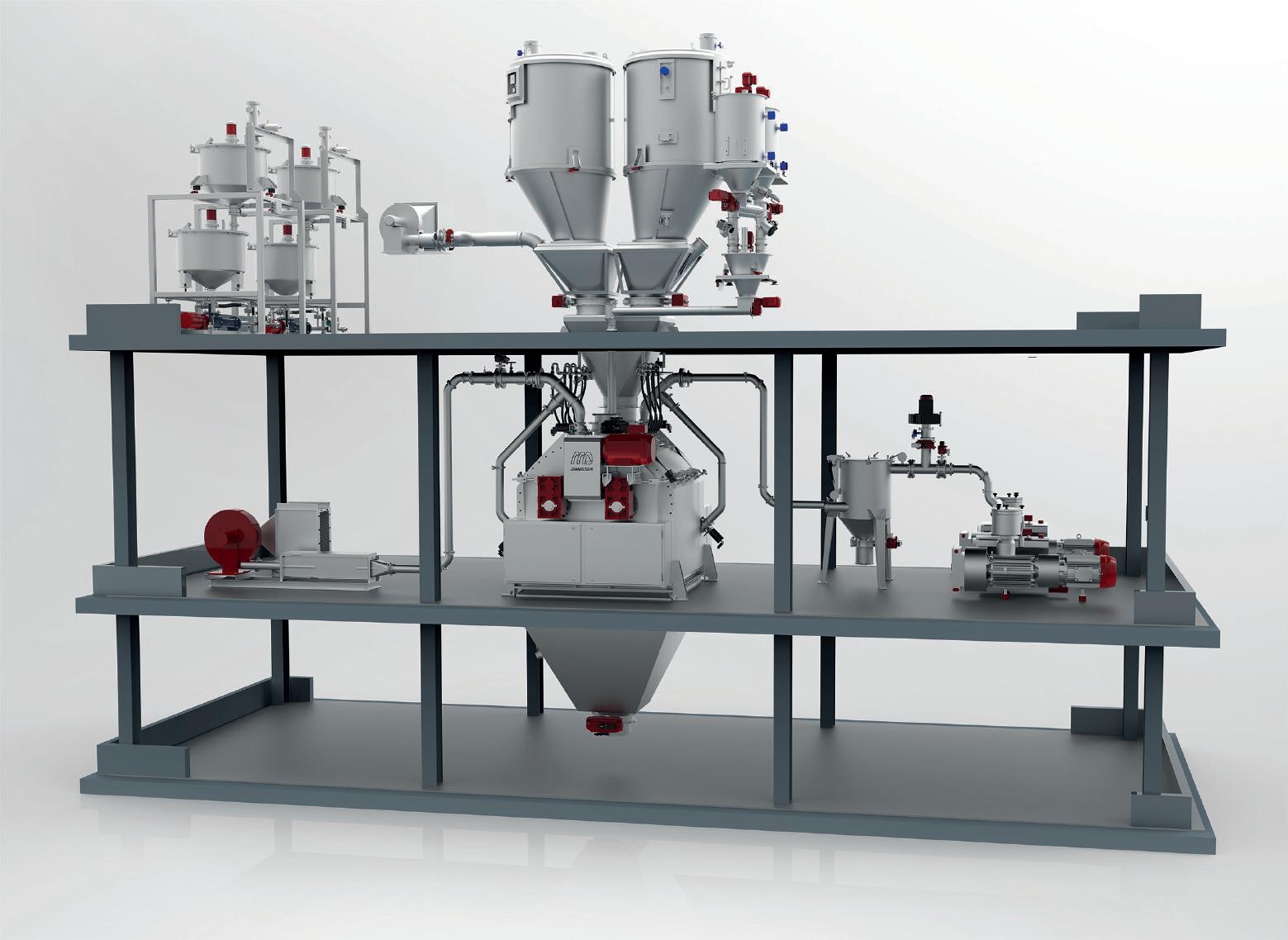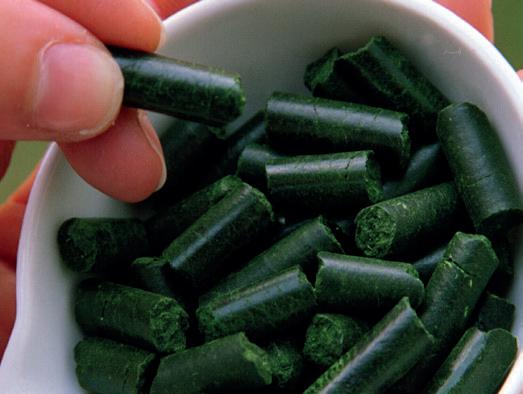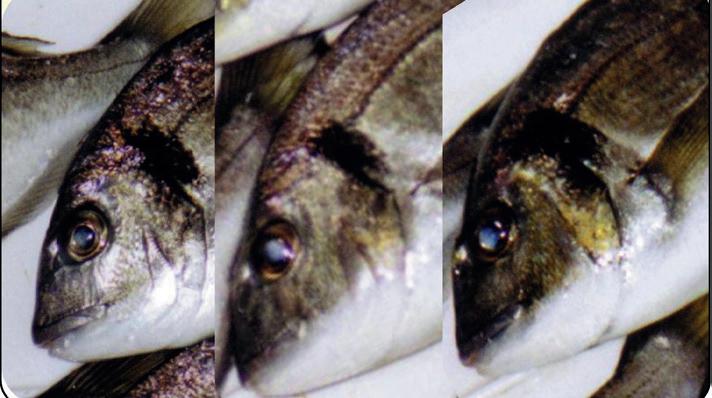
5 minute read
The vacuum coating revolution in feed production
Peter Raeven, Dinnissen Process Technology
Figure 1. A detailed depiction of the vacuum coating process.
A brief history
In 1990, vacuum coating techniques were first introduced in the aquafeed production sector by Dinnissen Process Technology. The vacuum coater originated as an evolution of the Dinnissen Pegasus® Paddle Mixer. In mixing experiments carried out under vacuum conditions, high concentrations of liquid were sprayed onto feed pellets. When the vacuum was removed, the liquid was sucked deep into the coated pellets. In this way, Dinnissen succeeded in gradually increasing the fat content of the pellets. Compared to atmospheric systems, up to 80 % extra liquid could be added to pellets coming from the pellet presses. The Pegasus® Vacuum Coater enabled feed producers to apply liquid additives to and into pellets and xtruded products by creating a vacuum environment within the production process.
How does it work?
Vacuum coating technology allows producers of animal feed to create a vacuum environment within their production processes, enabling them to deal with a wide variety of challenges.
The process starts with creating a vacuum inside the vacuum coater where multiple layers of additives can be applied to the product. The Pegasus® Vacuum Coater gently suspends ingredients homogeneously in the air while the vacuum unit creates a vacuum environment. The spraying functionality makes it possible to spray a precisely predetermined quantity of liquid onto the powders, pellets or granules. When air is then allowed to enter the mixing unit, the liquids are evenly distributed deeply into each particle. With the ingredients being sucked deep into the particles through the vacuum, it also has the effect of protecting them against crumbling. After this step, additional layers of top coatings or aromas are applied to each particle, which results in a high-quality extruded product. Often a thin layer of fat is applied to the granular feed material. This extra protective layer makes the material more elastic so that it breaks or crumbles less quickly. All this is done very fast, since the entire batch process takes just a couple of minutes.
The added value of vacuum coating in feed production
After years of developing, optimizing and innovating, the benefits of using vacuum coaters speak for themselves: • More nutritious feed: Preservation of the action of functional additives such as vitamins, minerals, ameliorators, taste enhancers, yeast and enzymes. • Retention of taste and color of feed. • Energy-rich feed via the addition of high
Figure 2. Pegasus® vacuum coating system.

percentages of oil or fat results in faster and better growth of animals. • Better feed leads to better digestion, which results in better growth. • Better digestion leads to the reduction of nitrogen, ammonia, phosphate and/or methane emissions (feces). • Healthier animals, and less loss of livestock. • Flexible production processes with sophisticated control programs allow producers to optimize the “recipe” of their product to create an even better feed. • Extremely precise and homogeneous dosing of (expensive) additives, micro-dosing with very high accuracy. • Applicable in different production settings: convenient, easy-to-use and easy-to-clean. • Adding functional additives at the right moment (end-of-line, preconditioning and pressure stage).
By using vacuum coaters, functional additives can be introduced in the final stages of the production process. Additives, including a wide range of substances such as oils, fats, vitamins, minerals, enzymes, prebiotics and probiotics, taste enhancers, yeast and other enhancers, can be added to powders, particles and granules. Functional active ingredients can be processed as powders or liquids, and are always added in the vacuum coater after the heating and pressure stages. This functionality of vacuum coaters ensures that heat-sensitive substances remain active after being added to the product. Another advantage of introducing functional additives in the vacuum coater is that the (expensive) additives can be dosed homogeneously and with extreme precision.
The vacuum coating process not only preserves the action of functional additives, such as vitamins, minerals, ameliorators, yeast and enzymes, it also helps with retaining the taste and color of the product. An additional advantage of vacuum coating is that pellets aren’t greasy on the outside anymore. This increases the flow out of the silo, prevents pollution and reduces contamination at farms.
The Pegasus® Vacuum Coater vs traditional production methods
Vacuum coaters are used primarily for adding essential ingredients such as aromas, oils, vitamins, minerals and enzymes to granules and extruded products. The Pegasus® Vacuum Coater makes it possible to add precisely the right amount of powder or liquid to each granule, after which the additive penetrates deeply into the granule. With the same technology, batches of solid as well as liquid ingredients can be mixed quickly and very homogeneously. The Pegasus® Vacuum Coater is capable of adding much larger quantities of additives to powders, granules and granulates, than traditional production methods.
Additionally, it’s possible to quickly add several coatings (one after another) on granules and extruded products and to vary the effect of the vacuum process. For example, switching the vacuum on and off controls the depth to which the liquid additives penetrate into the granule.
The sophisticated control program makes it easy for producers to vary the vacuum settings and with it the injection of powders and liquids. As a result, the vacuum coater is suitable for producing a wide range of products on a single production line. Varying with ingredients and switching between recipes is fast and convenient. This also applies to the production of small quantities.
• Energy-rich, non-sticky and good running granules • Strong pellet, no dust, fewer recalls • Improved efficiency and feed conversion • Lower energy need for production • Possibility of adding components ‘end-of-line’ • Less odor emission, fat/oil is not overheated • Mixing/blending with vacuum processing capabilities • Highly accurate feeding, weighing and liquid dosing • No contamination and hygienic design for fast and easy cleaning • Suitable for fragile and extruded products • Optimum quality, safety and homogeneity of product, used by many premium brands With a production capacity of up to 30 t/h per unit and batch sizes from 10 up to 3,000 l/batch, Pegasus® Vacuum Coater allows a fast mixing with double shaft paddle mixing technology and a low coefficient of variation. It is fitted with vacuum-tight exclusion valves that have an FDA-approved type seal, developed exclusively by Dinnissen.
More information: Peter Raeven
Account Manager Dinnissen Process Technology, The Netherlands E: powtech@dinnissen.com
PIGMENTATION AND GROWTH PERFORMANCE
1100 % natural xanthophylls pigments for greater golden or orange-pink coloring for feeding fish and crustacean
Pellets or crumble

2
High quality vegetable protein content for improved growth performance
3

French origin, non GM product, «VLOG geprüft»
DESIALIS - 27/29 rue Chateaubriand 75008 PARIS - + 33 (0)1 42 99 01 01- www.desialis.com - info@desialis.com








